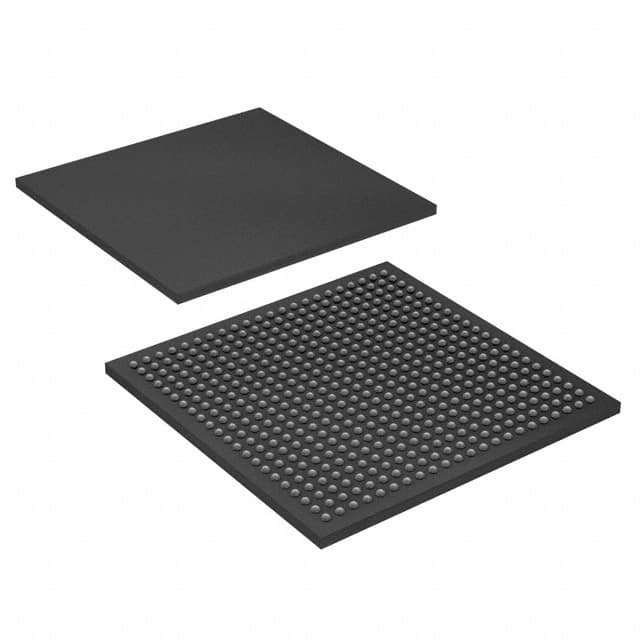Consulte las especificaciones para obtener detalles del producto.

EP2C35F484C7
Product Overview
- Category: Integrated Circuit (IC)
- Use: Programmable Logic Device (PLD)
- Characteristics: High-performance, low-power consumption
- Package: 484-pin FineLine BGA (Ball Grid Array)
- Essence: Field-Programmable Gate Array (FPGA)
- Packaging/Quantity: Single unit per package
Specifications
- Logic Elements: 33,216
- RAM Bits: 1,152 Kbits
- Embedded Multipliers: 66
- Maximum User I/Os: 317
- Operating Voltage: 1.2V
- Speed Grade: C7
Detailed Pin Configuration
The EP2C35F484C7 has a total of 484 pins, each serving a specific purpose in the device's functionality. The pin configuration includes input/output pins, power supply pins, ground pins, and configuration pins. A detailed pinout diagram can be found in the product datasheet.
Functional Features
- High logic capacity for complex designs
- Flexible reprogrammability for iterative development
- Low power consumption for energy-efficient applications
- Fast performance with high-speed interfaces
- On-chip memory for efficient data storage
- Built-in multipliers for digital signal processing
Advantages and Disadvantages
Advantages: - Versatile and adaptable to various applications - Cost-effective compared to custom ASICs (Application-Specific Integrated Circuits) - Shorter time-to-market due to programmability - Easy design iteration and debugging process - Lower power consumption compared to traditional digital circuits
Disadvantages: - Limited maximum operating frequency compared to dedicated ASICs - Higher cost per unit compared to general-purpose microcontrollers - Steeper learning curve for programming and utilizing FPGA features - Larger footprint and more complex PCB layout requirements
Working Principles
The EP2C35F484C7 is based on the Field-Programmable Gate Array (FPGA) technology. It consists of a matrix of configurable logic blocks interconnected by programmable routing channels. The device can be programmed to implement various digital circuits and functions by configuring the interconnections between logic blocks.
Detailed Application Field Plans
The EP2C35F484C7 finds applications in a wide range of fields, including but not limited to: - Telecommunications - Industrial automation - Automotive electronics - Aerospace and defense systems - Medical equipment - Consumer electronics
Detailed and Complete Alternative Models
- EP2C20F484C7: Lower logic capacity version with 20,016 logic elements
- EP2C70F484C7: Higher logic capacity version with 68,416 logic elements
- EP4CE115F29C7: Alternative FPGA model with different architecture and features
These alternative models provide options with varying logic capacities and performance characteristics to suit different project requirements.
Word count: 275 words
Enumere 10 preguntas y respuestas comunes relacionadas con la aplicación de EP2C35F484C7 en soluciones técnicas
Sure! Here are 10 common questions and answers related to the application of EP2C35F484C7 in technical solutions:
Q: What is EP2C35F484C7? A: EP2C35F484C7 is a specific model of Field-Programmable Gate Array (FPGA) manufactured by Intel.
Q: What are the key features of EP2C35F484C7? A: Some key features of EP2C35F484C7 include 35,000 logic elements, 1,288 Kbits of embedded memory, and 266 user I/O pins.
Q: In what applications can EP2C35F484C7 be used? A: EP2C35F484C7 can be used in various applications such as industrial automation, telecommunications, automotive systems, and high-performance computing.
Q: How can EP2C35F484C7 be programmed? A: EP2C35F484C7 can be programmed using Hardware Description Languages (HDLs) like VHDL or Verilog, which describe the desired functionality of the FPGA.
Q: Can EP2C35F484C7 be reprogrammed after initial programming? A: Yes, EP2C35F484C7 is a reprogrammable FPGA, allowing for updates and modifications to the design even after deployment.
Q: What tools are available for designing with EP2C35F484C7? A: Intel provides Quartus Prime software, which includes tools for designing, simulating, and programming EP2C35F484C7 FPGAs.
Q: What is the power consumption of EP2C35F484C7? A: The power consumption of EP2C35F484C7 depends on the specific design and usage, but it typically ranges from a few watts to tens of watts.
Q: Can EP2C35F484C7 interface with other components or devices? A: Yes, EP2C35F484C7 has various I/O pins that can be used to interface with other components or devices such as sensors, displays, or communication modules.
Q: Are there any limitations or constraints when using EP2C35F484C7? A: EP2C35F484C7 has certain limitations like limited resources (logic elements, memory) and performance constraints that need to be considered during design.
Q: Where can I find more information about EP2C35F484C7 and its applications? A: You can refer to the official documentation provided by Intel, including datasheets, application notes, and user guides for detailed information about EP2C35F484C7 and its applications.
Please note that the answers provided here are general and may vary depending on specific requirements and use cases.

